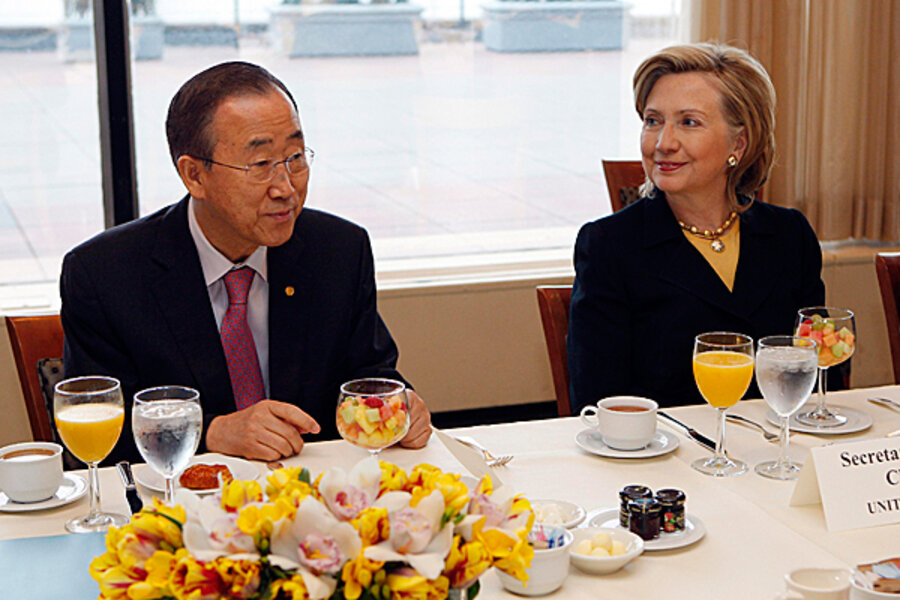Aim of UN donors meeting: $3.8 billion to rebuild a better Haiti
Loading...
| United Nations, N.Y.
The global spotlight that focused on Haiti’s monumental rescue and stabilization efforts in the weeks after the devastating Jan. 12 earthquake turns back to the Caribbean nation Wednesday.
This time, the international community seeks to finance and fashion a multibillion-dollar reconstruction program that doesn’t just repair the weak and impoverished country but uses the opportunity to build a better Haiti.
The United States and the United Nations are co-hosting a high-level donors’ conference that US officials say will draw more than 100 countries and international development organizations. The goal is to secure an initial $3.8 billion in international pledges for a decade-long recovery program the Haitian government estimates at $14 billion.
IN PICTURES: Rebuilding after an earthquake
The international community will express a common spirit of support for Haiti in opening remarks to be offered by leaders including Secretary of State Hillary Rodham Clinton, UN Secretary General Ban Ki-moon, and his special envoy for Haiti Bill Clinton. Haitian President René Préval will outline his government’s plan for national renewal.
What role for whom?
But several contentious issues will have to be addressed if Haiti’s massive reconstruction effort is to be a success: Is the international community turning too quickly to visions of rebuilding what is virtually a failed state, when the immediate relief needs of millions of Haitian people are unmet? Is it wise to expect the Haitian government to take charge of the rebuilding effort, given that its weaknesses were only compounded by a natural disaster? And is the US taking too dominant a role in the rebuilding program?
“This is not a traditional donors’ conference; this goes far beyond simply rebuilding the physical structures destroyed by an earthquake,” says Francois Pierre-Louis, a political scientist and Haiti expert at Queens College in Flushing, N.Y. This one-day conference is about building the tangible (physical infrastructure) and the intangible (such as governance), he says, “and it may be too ambitious to do both at once.”
Some international development experts and US officials cite the reconstruction of Aceh in Indonesia after the 2004 tsunami as an example of how rebuilding can be done successfully – and they say the international community can apply the lessons it learned in Aceh to Haiti. But others say the Haiti reconstruction will be more daunting, in part because an already-ineffectual nation was decimated by the disaster.
“It’s going to be a challenge. I don’t think anyone thinks it’s not going to be a challenge, and the government of Haiti thinks it’s going to be a challenge,” says Cheryl Mills, Secretary Clinton’s special counselor on Haiti. She notes, for starters, that 28 of Haiti’s 29 ministry buildings collapsed.
A commission to oversee the plan
The government’s weak starting point post-quake is one reason a provisional development commission is being set up. With eight of its 13 members from outside Haiti, the commission will oversee implementation of the renewal plan – and in particular the disbursement of the mountains of international funding.
Some Haitians have taken that aspect of the development plan as a slap in the face, but Ms. Mills dismisses criticisms and says the commission’s make-up reflects both aspirations and realities on the ground.
“President Préval has been very clear that they need to be in the lead,” she says, “but he also recognizes that their capacities are considerably diminished.”
Queens College’s Mr. Pierre-Louis, a Haitian-American, says governance and the rule of law will be key factors determining progress in Haiti. “How are you going to reform the state so that money gets out of Port-au-Prince” to the poor and underdeveloped provinces? “Who’s going to make sure the money isn’t wasted and stolen?”
Haiti lost more than 100,000 houses in the earthquake, and replacing that lost housing will be a top challenge to the government and to the plan for a “better” Haiti, Pierre-Louis adds. “Who’s going to have the authority to tell a Haitian man or a Haitian woman not to rebuild his or her house the way it was before?”
Speed is of the essence
While international officials place an emphasis on getting Haiti’s plan right, some Haitians say it’s also going to be important to act fast if key parts of the plan are to have any chance.
For example, Mr. Préval wants to use the exodus of perhaps 300,000 families from Port-au-Prince after the quake as a starting point for decentralizing the country, revitalizing agriculture, and decongesting an overcrowded capital.
But Pierre-Louis says Haitians who left an impoverished and poorly serviced countryside once won't have much faith that dreamy plans for robust agriculture and dynamic secondary cities will ever materialize.
“People who left are already returning to Port-au-Prince,” he says, “Relief aid never got to them in the rural areas, so they don’t believe it will be any different when it comes to rebuilding the country.”





